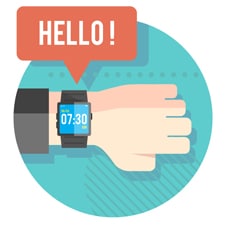Anyone who’s seen movies like “The Terminator,” “Minority Report,” “Ironman” and beyond has seen the marriage of technology and fashion. There’s a giant laundry list of wearable gadgets that grace the silver screen. Only now, wearable technology is becoming part of everyday reality. But are we ready to adopt?
When Google Glass first launched, it was widely met with skepticism, resistance and, of course, a lively public conversation about personal privacy. Me? I would happily volunteer to have a chip embedded in my earlobe to replace the smartphone in my hand. Luckily, Google Glass came first.
I recently attended a Google Developers meeting, where I was impressed to learn about the boundaries Google is self-imposing to make people feel more comfortable around Glass wearers. In an effort to remove much of the stigma caused by concerns about privacy intrusions, Google says it will not allow any app using facial recognition to enter the Glassware app marketplace. That’s a personal win for proponents like me — but Google Glass (and it’s $1,500 price) has also raised questions about what wearable technology looks like (in this instance, let’s say dorky) and whether a gadget actually has a definable use, at a price an average human can afford.
 In general, the promise of wearable technology is huge. Smartwatches, health monitors, security devices, media gadgets and high-tech eyewear are popping up everywhere. Hundreds of other wearable concepts, including remote control eyelashes, are on their way, too. But to catapult the technology into widespread use, wearables need to combine function with fashion at an affordable price point.
In general, the promise of wearable technology is huge. Smartwatches, health monitors, security devices, media gadgets and high-tech eyewear are popping up everywhere. Hundreds of other wearable concepts, including remote control eyelashes, are on their way, too. But to catapult the technology into widespread use, wearables need to combine function with fashion at an affordable price point.
Toeing the Form + Function Line
As the steppingstone to true wearable technology, enter the smartwatch (various models of which I covered in a Chicago Bar Association post here). Smartwatches can pair with smartphones to mirror call, text and alert functions, or otherwise offer voice-control options for your most commonly used features, delivering them to your wrist. No more struggling to answer a call while your arms are filled with groceries, or frantically digging into your pocket or purse to see a gate-change alert while your hands are dragging luggage through the airport. Plus, some models offer Internet capabilities, email previews, media display and calendar functions, and run apps, to.
Still more features are arriving in “smartwatch 2.0” models. In redesigns begun after a first round of ho-hum sales numbers, retail technology houses like Samsung, Sony and Toshiba are giving it another go with more opulent, faster and functionally sound devices that promise impressive upgrades.
The most significant addition is seen in Toshiba’s Smartwatch Prototype, which uses a built-in ECG to monitor your unique pulse pattern so it can identify you, as the device wearer, and release security barriers around private information if someone else slips on your watch. Samsung has also jumped on board, adding a heart-rate sensor and fitness tracking tools to its Galaxy Gear 2. Think about it: You can answer calls, check email, monitor your eating and workouts, and speak text message responses right into your wrist — hands free.
Other Wearables That Might Enhance Your Life
Fitness is a multi-billion-dollar business, so it’s no coincidence that the smartwatches released this year includes built-in heart rate monitors, fitness tracking tools and a plethora of apps enticing users to get out and get active. Of course, if a smartwatch isn’t for you, there are popular fitness wearables such as the Nike Fuel Band and Fit Bits.
What else is in the wearables wardrobe, or coming soon? A lot. Here’s just a sample.
- Like the sound of smart headphones? Then you might like Dash Smart Headphones by Bragi. Launched through a Kickstarter campaign, these sleek, completely wireless in-ear headphones look like an athlete’s new best friend. They track fitness stats and monitor vitals like heart rate and oxygen saturation, while also functioning as a (no cables!) music player. They pair with MP3 players and smartphones via Bluetooth, and since there’s a built-in mic, you can even take calls while you run, bike, work out or commute your way around town.
- Want to improve your posture? Lumo Lift is housed in a small magnetic clasp (available in 10 colors) that will alert you when your posture is out of place, the perfect substitute for mom’s childhood reminders. It requires an iOS device to run and starts shipping this summer (with an Android-compatible version promised for soon after).
- Diabetic? Google Glucose Monitoring Contact Lenses have entered the development phase. Not quite the feature set of their grown-up cousin Google Glass, but with a more immediate, specific function, addressing symptoms of diabetes. These contact lenses aim to alert wearers of low glucose levels, preventing insulin shock before it happens. Diabetic patients (and their fingers) are optimistic that wearing a contact lens would displace their need for blood testing throughout the day.
- Couch surfer extraordinaire? Welcome the Ring. Also funded through Kickstarter, the Ring is more like Harry Potter’s magic wand — it lets you control home appliances and apps by writing letters or making waving gestures with your finger.
- A parent looking for anxiety reduction? If you’ve sent a daughter off to college or ever wondered where your high-schooler is, the Cuff might offer some peace of mind, and make you the star of your next PTA meeting. This thumbnail-size device can be placed inside a slew of beautiful bracelets, watches, necklaces and more. The touch of a button sends an emergency signal to your chosen group of family members. Members wearing a Cuff will receive a vibration; those without will receive a push notification through the CuffLinc app.
The Price Point?
Shelling out $1,500 for a pair of Google Glasses is, well … ridiculous. Only a nerd of nerds or a developer with gobs of cash to burn is going to buy in at this price point. But most of the wearable tech pieces I’ve mentioned hover between $150 to $500. Still a bit high, but not too far out of reach. To add to the price, though, you will need a serious smartphone to truly reap the rewards of the device, so the combined purchase approaches the $1,000 mark. We can expect to see a huge uptick in sales when prices for the secondary devices drop to $100 to $200.
In reality, few will completely replace their smartphone with a wearable like a smartwatch — who wants to view videos on a watch face, or type teeny-tiny text messages into their wrists? So what it comes down to is this: Sometimes your smartphone gets in the way. For some, a wearable could relocate the distractions of a smartphone (at least on occasion), and let us get back to real life — it requires two hands!
Chelsey Lambert serves as the Chicago Bar Association’s Law Practice Management Technology, Trainer and Coordinator. Her role is to bridge the gap between the education attorneys and legal professionals need, through availability, variety and access. She focuses her efforts on the creation and delivery of curriculum through training online, in person, video tutorials and the LPMT Blog. She was previously President and founder of Virtulawso. Follow her on Twitter @ChelseyLambert.
Sponsored Links
»Register Today: 4th Annual Super Marketing Conference, June 5, Boston.
»Start Saving Time: Top cloud-based practice management software
»Manage my legal practice from anywhere on any device—HoudiniEsq.
»Learn more about the easiest way to get paid.
»Work from anywhere. Intuitive legal practice management software. Free trial.
Illustration © iStockPhoto.com. Eyelashes image © Katia Vega, www.beautytechnology.com.























